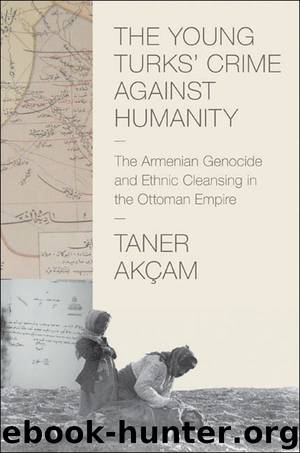The Young Turks' Crime against Humanity by Akçam Taner

Author:Akçam, Taner
Language: eng
Format: epub
Publisher: Princeton University Press
Published: 2012-03-08T16:00:00+00:00
THE BLACK BOOK OF TALAT PASHA, OR A RÉSUMÉ OF DEPORTATIONS AND KILLINGS
In 2008 Turkish journalist Murat Bardakçı published some documents that he identified as “the daily journal of Talat Pasha.” The titles of these undated documents are important: (1) “The Numbers of Armenians Deported”; (2) “A General Accounting of the Armenian Population after Deportation”; (3) “Armenian Orphans (Numbers Distributed to Muslims and Existing Today)”; (4) “Quantity of Abandoned Empty Houses from Armenians”; (5) “Table Showing Farm Estates Abandoned by Armenians”; and (6) “Mining Concessions in the Charge of Armenians.” In particular, the document called “A General Accounting of the Armenian Population after Deportation” provides detailed figures for cities in every province and provincial district on the numbers of “local Armenians,” “outsider Armenians and where they came from,” and how many of the Armenians of that city were to be found in other cities.42
No date is given on the documents, but it is quite probable that they were prepared in early 1918 and contain a general accounting of the deportations. Work on them began at the end of 1916. In the last months of 1916, a final inventory was attempted in order to determine how many Armenians had survived the deportations and killing operations. For this purpose Talat Pasha sent a general communiqué to all provinces and districts on 24 September 1916, asking each local administrator to prepare a list containing the number of remaining Armenians within their respective jurisdictions. The request was repeated on 29 and 30 October with follow-up cables to local administrators who were reminded to “send the first draft of the list concerning the number of Armenians in your province/provincial district as requested on 24 September 1916.”43
These lists were expected to answer a number of questions that had originally been sent to all regions. The Interior Ministry closely monitored which provinces submitted their reports in a timely fashion. Those that failed to do so received follow-up requests—accompanied by veiled warnings—to submit the required information. A 5 December 1916 cable to Adana demanded “the speedy compilation and dispatch of a list concerning the number of Armenians.”44 On the same day, the provincial district of Urfa was asked to “quickly send back the list concerning the number of Armenians [in your area] without leaving out a single locale.”45 The 25 December 1916 telegrams to the provinces of Diyarbekır, Damascus, and Mamuretülaziz, and to the provincial district of Der Zor serve as further examples: “Resend with the first post the list, requested on 24 September 1916, containing the figures for the number of Armenians in [your] province/provincial district.”46
Some communications included an explicit rationale for demanding the lists. A cable to Kütahya on 14 February 1917, having criticized the previous report for “not clarifying the places of origin of the Armenians inside the provincial district,” explained that “the purpose in asking the numbers of these [people] is to understand their place of origin, the condition in which they have arrived and remained there. It is necessary that these aspects be clearly and fully explained.
Download
This site does not store any files on its server. We only index and link to content provided by other sites. Please contact the content providers to delete copyright contents if any and email us, we'll remove relevant links or contents immediately.
| Arms Control | Diplomacy |
| Security | Trades & Tariffs |
| Treaties | African |
| Asian | Australian & Oceanian |
| Canadian | Caribbean & Latin American |
| European | Middle Eastern |
| Russian & Former Soviet Union |
The Secret History by Donna Tartt(18846)
The Social Justice Warrior Handbook by Lisa De Pasquale(12141)
Thirteen Reasons Why by Jay Asher(8796)
This Is How You Lose Her by Junot Diaz(6794)
Weapons of Math Destruction by Cathy O'Neil(6146)
Zero to One by Peter Thiel(5686)
Beartown by Fredrik Backman(5599)
The Myth of the Strong Leader by Archie Brown(5425)
The Fire Next Time by James Baldwin(5249)
How Democracies Die by Steven Levitsky & Daniel Ziblatt(5128)
Promise Me, Dad by Joe Biden(5087)
Stone's Rules by Roger Stone(5026)
A Higher Loyalty: Truth, Lies, and Leadership by James Comey(4845)
100 Deadly Skills by Clint Emerson(4840)
Rise and Kill First by Ronen Bergman(4704)
Secrecy World by Jake Bernstein(4646)
The David Icke Guide to the Global Conspiracy (and how to end it) by David Icke(4625)
The Farm by Tom Rob Smith(4437)
The Doomsday Machine by Daniel Ellsberg(4416)
